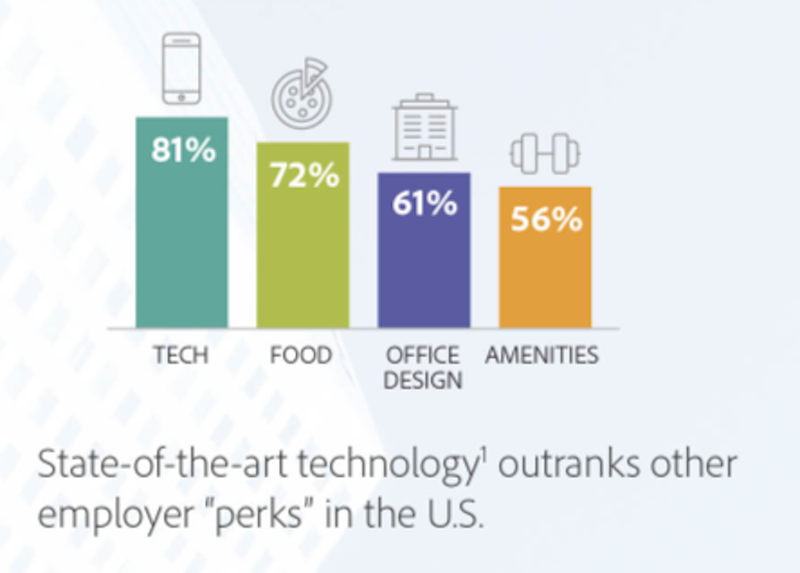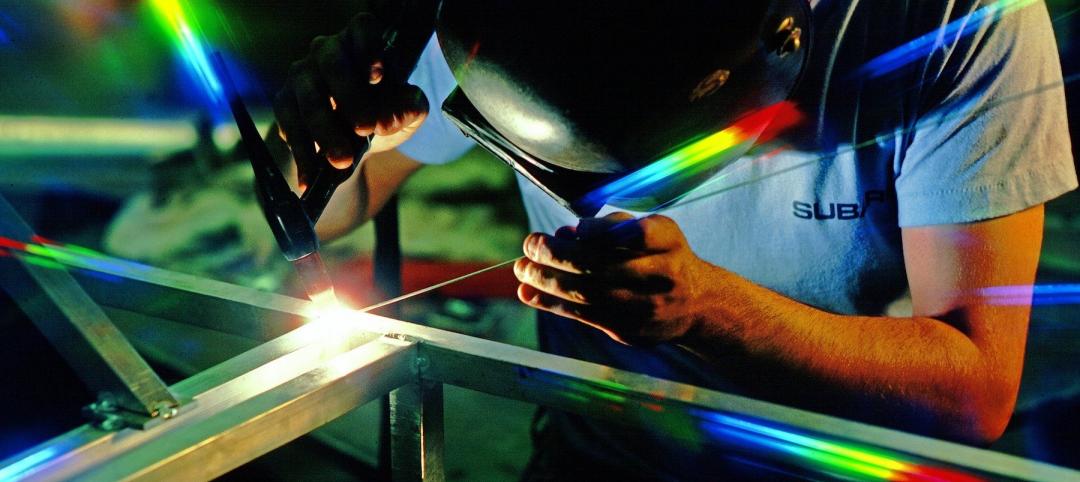American office workers love their jobs, and love them even more when the technology their companies use is viewed as being ahead of the curve.
A recent online survey of more than 1,000 office workers in the U.S., which Adobe conducted during two weeks last month, finds 70% saying they love what they do. And a remarkable 81% say that state-of-the-art technology was more important to them than an office’s design or on-site amenities.
Seven out of 10 U.S. workers believe technology improves the work-life balance, and 81% say technology helps them connect with colleagues more efficiently. Those respondents who think their company’s technology is “ahead of the curve” feel about twice as creative, motivated, and satisfied as respondents who work for companies with less-than-cutting edge technology.
The rub is that only 25% of the survey’s U.S. respondents think their company’s technology excels. Nevertheless, more than half (53%) expects technology to be handling more of their offices’ menial tasks—copying, filing, etc.—over the next two decades, even as 55% remain convinced their jobs could never be replaced by a machine.
In fact, there seems to be more than a hint of ambivalence about the benefits of technology among the 75% of respondents who are concerned that relationships and health suffer when people become to attached to their devices.

Technology trumps other office amenities in what keeps workers content. Image: Adobe's “Work in Progress” report.
The Adobe survey portrays an American workforce for which work and life are inseparable, almost to the point of obsession. More than half of the respondents say they’d keep working if they won the lottery. U.S. workers say they spend, on average, 78% of their waking hours during the work week and 41% of their days off thinking about their jobs. Indeed, 57% of respondents agree with the statement “work defines who I am.”
The desire to work is further punctuated by the finding that one in three U.S. office workers moonlights in jobs outside of his or her primary occupation, and that moonlighters are more likely to be happier and more optimistic than non-moonlighters.
However, 69% of U.S. workers also say they work multiple jobs because they need the money. Nearly three-fifths of American workers are likely to leave their jobs for a better opportunity. (That number is 50% even among people who say they profess love for their current job.)
Related Stories
Wood | Nov 16, 2022
5 steps to using mass timber in multifamily housing
A design-assist approach can provide the most effective delivery method for multifamily housing projects using mass timber as the primary building element.
Giants 400 | Nov 14, 2022
4 emerging trends from BD+C's 2022 Giants 400 Report
Regenerative design, cognitive health, and jobsite robotics highlight the top trends from the 519 design and construction firms that participated in BD+C's 2022 Giants 400 Report.
Contractors | Nov 14, 2022
U.S. construction firms lean on technology to manage growth and weather the pandemic
In 2021, Gilbane Building Company and Nextera Robotics partnered in a joint venture to develop an artificial intelligence platform utilizing a fleet of autonomous mobile robots. The platform, dubbed Didge, is designed to automate construction management, maximize reliability and safety, and minimize operational costs. This was just one of myriad examples over the past 18 months of contractor giants turning to construction technology (ConTech) to gather jobsite data, manage workers and equipment, and smooth the construction process.
University Buildings | Nov 13, 2022
University of Washington opens mass timber business school building
Founders Hall at the University of Washington Foster School of Business, the first mass timber building at Seattle campus of Univ. of Washington, was recently completed. The 84,800-sf building creates a new hub for community, entrepreneurship, and innovation, according the project’s design architect LMN Architects.
Sponsored | Steel Buildings | Nov 7, 2022
Steel structures offer faster path to climate benefits
Faster delivery of buildings isn’t always associated with sustainability benefits or long-term value, but things are changing. An instructive case is in the development of steel structures that not only allow speedier erection times, but also can reduce embodied carbon and create durable, highly resilient building approaches.
Mass Timber | Aug 30, 2022
Mass timber construction in 2022: From fringe to mainstream
Two Timberlab executives discuss the market for mass timber construction and their company's marketing and manufacturing strategies. Sam Dicke, Business Development Manager, and Erica Spiritos, Director of Preconstruction, Timberlab, speak with BD+C's John Caulfield.
Green | Jul 26, 2022
Climate tech startup BlocPower looks to electrify, decarbonize the nation's buildings
The New York-based climate technology company electrifies and decarbonizes buildings—more than 1,200 of them so far.
Building Technology | Jun 9, 2022
GSA Green Proving Ground program selects six innovative building technologies for evaluation
The U.S. General Services Administration’s (GSA) Green Proving Ground program, in collaboration with the U.S. Department of Energy, has selected six innovative building technologies for evaluation in GSA’s inventory.
Smart Buildings | Jun 1, 2022
Taking full advantage of smart building technology
Drew Deatherage of Crux Solutions discusses where owners and AEC firms could do better at optimizing smart technology in building design and operations.
Sponsored | BD+C University Course | May 10, 2022
Designing smarter places of learning
This course explains the how structural steel building systems are suited to construction of education facilities.

















